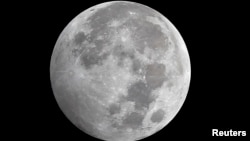Scientists believe they know why the near side of the moon appears to have larger impact craters than the far side.
"Since time immemorial, humanity has looked up and wondered what made the man in the moon," said Maria Zuber, a geophyisics professor the Massachusetts Institute of Technology (MIT) and the principal investigator with NASA's Gravity Recovery and Interior Laboratory (GRAIL). "We know the dark splotches are large, lava-filled, impact basins that were created by asteroid impacts about four billion years ago. GRAIL data indicate that both the near side and the far side of the moon were bombarded by similarly large impactors, but they reacted to them much differently.”
Much of the bombardment of the moon occurred about 4 billion years ago, an era termed the Late Heavy Bombardment (LHB). During that time, a hailstorm of giant asteroids pummeled the solar system, slamming into the moon, along with young planets like Mercury, Venus, Earth, and Mars. Earth lacks most traces from this period because of erosion and plate tectonics.
Data from NASA’s twin GRAIL probes, which orbited the moon from January to December 2012. During its mission, the probes circled the moon, making measurements of its gravity. Scientists from MIT and the University of Paris used this data to generate a highly detailed map of the moon’s crust, showing areas where the crust thickens and thins. In general, the group observed that the moon’s near side has a thinner crust than its far side.
Katarina Miljkovic of the Institut de Physique du Globe de Paris, generated computer simulations of asteroid impacts on the moon by plugging in crustal thickness data from GRAIL. Milijkovic also incorporated estimates of the moon’s early internal temperatures from thermal modeling, based in part on lava deposits that flooded the large impact basins on the moon’s near side. Scientists have observed that more volcanic activity occurred on the near side, generating higher internal temperatures than on the moon’s far side.
“Impact simulations indicate that impacts into a hot, thin crust representative of the early moon’s near-side hemisphere would have produced basins with as much as twice the diameter as similar impacts into cooler crust, which is indicative of early conditions on the moon’s far-side hemisphere,” notes Miljkovic.
Together, the findings seem to indicate that the asteroids impacted the moon with less intensity than previously thought during the LHB. The asteroids also may have been smaller than previously thought.
Zuber said the near side’s thinner crust and higher temperatures may have made the surface more deformable than the thicker, cooler crust of the moon’s far side. These results suggest that the LHB may have involved less massive asteroids than scientists have thought.
“I’d certainly been a believer in the Late Heavy Bombardment from looking at those large impact basins,” Zuber said. “The idea of a Late Heavy Bombardment remains, but it will be have to be re-examined.”
Here's a short video about the study:
"Since time immemorial, humanity has looked up and wondered what made the man in the moon," said Maria Zuber, a geophyisics professor the Massachusetts Institute of Technology (MIT) and the principal investigator with NASA's Gravity Recovery and Interior Laboratory (GRAIL). "We know the dark splotches are large, lava-filled, impact basins that were created by asteroid impacts about four billion years ago. GRAIL data indicate that both the near side and the far side of the moon were bombarded by similarly large impactors, but they reacted to them much differently.”
Much of the bombardment of the moon occurred about 4 billion years ago, an era termed the Late Heavy Bombardment (LHB). During that time, a hailstorm of giant asteroids pummeled the solar system, slamming into the moon, along with young planets like Mercury, Venus, Earth, and Mars. Earth lacks most traces from this period because of erosion and plate tectonics.
Data from NASA’s twin GRAIL probes, which orbited the moon from January to December 2012. During its mission, the probes circled the moon, making measurements of its gravity. Scientists from MIT and the University of Paris used this data to generate a highly detailed map of the moon’s crust, showing areas where the crust thickens and thins. In general, the group observed that the moon’s near side has a thinner crust than its far side.
Katarina Miljkovic of the Institut de Physique du Globe de Paris, generated computer simulations of asteroid impacts on the moon by plugging in crustal thickness data from GRAIL. Milijkovic also incorporated estimates of the moon’s early internal temperatures from thermal modeling, based in part on lava deposits that flooded the large impact basins on the moon’s near side. Scientists have observed that more volcanic activity occurred on the near side, generating higher internal temperatures than on the moon’s far side.
“Impact simulations indicate that impacts into a hot, thin crust representative of the early moon’s near-side hemisphere would have produced basins with as much as twice the diameter as similar impacts into cooler crust, which is indicative of early conditions on the moon’s far-side hemisphere,” notes Miljkovic.
Together, the findings seem to indicate that the asteroids impacted the moon with less intensity than previously thought during the LHB. The asteroids also may have been smaller than previously thought.
Zuber said the near side’s thinner crust and higher temperatures may have made the surface more deformable than the thicker, cooler crust of the moon’s far side. These results suggest that the LHB may have involved less massive asteroids than scientists have thought.
“I’d certainly been a believer in the Late Heavy Bombardment from looking at those large impact basins,” Zuber said. “The idea of a Late Heavy Bombardment remains, but it will be have to be re-examined.”
Here's a short video about the study:








